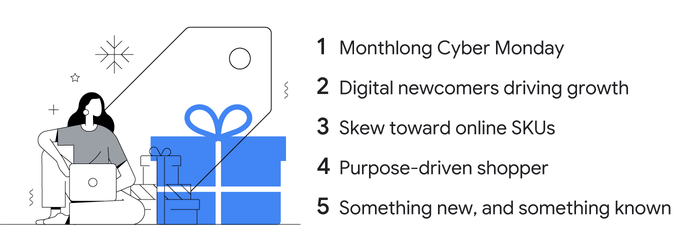What is the Holiday Retail Guide?
Each year, Google releases a Holiday Retail Guide that uses learnings from past years to allow your team to be fully prepared for this year’s holiday season.
Shoppers are looking for online solutions more than ever these days, so it is important for your retail team to be proactive in planning for the holiday season. Diving into these learnings will allow you and your team to prepare for these shifts and adjust your online retail strategy accordingly.
Here are the 5 large shifts in shopper behavior detailed in the guide with a few of our own recommendations and suggestions. Happy holiday planning! 
Tips for Navigating New Shopping Behaviors
#1: Expect a Month Long Cyber Monday
Social distancing has changed people’s approach to shopping -- how, when, and where they shop has transformed due to the necessary restrictions put in place to prevent the spread of COVID-19. These shifts will continue to drive how shoppers approach holiday shopping.
Overall, shoppers are looking to start their holiday shopping earlier than ever with 62% of US shoppers planning on starting their holiday shopping early to avoid their desired items being out of stock items. This will effectively extend the timeframe in which shoppers are actively looking for holiday gifts, creating a month-long Cyber Monday.
This insight really drives home the idea that it is never too early to start planning.
Shoppers this year are gearing up to begin early, so your team should as well.
Here are a few questions to keep in mind for you digital marketing strategy for early holiday shoppers:
- Can we extend our holiday calendar in order to account for the early shoppers?
- What's our website's "out of stock" strategy? Is it possible to notify someone when their item is back in stock?
- What does the retargeting and paid search campaign strategy look like?
Additionally, this time at home has also allowed shoppers to do more research about the products that they are purchasing.
Shoppers are also particularly price conscious this year, so be sure to draw them in with great deals and promotions. However, while they may be looking for a bargain, they’re not ready to sacrifice quality: searches containing the phrase “best affordable” have increased 60% year over year.
If you aren't leveraging coupons this holiday season, you will miss out on bargain shoppers.
Seer recommends reassessing the product content that you have on your site:
- Do you have what users look for when considering purchasing that item?
- Are you sufficiently displaying all deals you are offering to shoppers?
#2: Expect Digital Newcomers to Drive Growth
Not only are more shoppers planning on starting their holiday shopping earlier, more shoppers than ever are planning on shopping online this holiday season. A whopping 69% of shoppers have reported that they will be shopping online more than they have in the past.
This presents an opportunity for new customer acquisition that your team can capitalize on:
- Are you targeting similar audiences with your campaigns to draw in potential new customers?
- Are your remarketing campaigns set to draw in new users who land on your site but do not convert?
- Is your team taking advantage of free product listings on Google Shopping?
Another important thing to consider is your site’s user experience:
- Are you driving away possible new shoppers with confusing, difficult to understand site navigation?
- Is the confusion promotion code experience too difficult for non-experienced users to use?
- Is the mobile site experience as seamless as the desktop experience?
- Do you have an up to date and optimized FAQ page to answer questions about shipping and return policy?
- Are you leveraging a chat bot?
We recommend carrying out a quick UX evaluation before the holiday season to identify and address any friction points in your site experience ahead of time.
💡 Interested in how our Analytics and Creative teams collaborated to drive a 168% increase in Ecommerce conversion rate? Read our case study.
#3: Anticipate a Skew Towards Online SKUs
Regardless if the items will be purchased fully online, picked up in store, or delivered through a curbside service, some part of that shopping experience will likely occur online. 77% of US shoppers will be looking online for gift ideas and will likely already know exactly what they are buying before they even enter a physical store. Searches for “available near me” have increased globally 100% year over year.
To prepare for this, be sure that your team has adequate Ecommerce tracking on your site. If Ecommerce tracking is already enabled, has it been updated to account for any changes your site has seen in the past year? As your users interact with different categories, products, and brand pages, they are leaving clues about what they are interested in.
By creating a dashboard in Google Data Studio, your team can monitor these trends and adjust their strategy accordingly.
Be sure to take advantage of the Shopping Insights, best sellers, and retail category Google reporting to get a more holistic view of the retail space during this holiday season.
There will be an increase in hybrid shopping experiences as well. Searches for “curbside pickup” have increased 3000% globally year over year. In anticipation of this, double check your Business Profile on Google to properly communicate vital information to your customers:
- What are your store hours?
- Do you currently offer a buy online, pick up in store option? Does your store have a curbside pickup service?
- What safety precautions have you taken to decrease the spread of COVID-19?
- Do local customers who previously shopped in person know you’re open?
💡 Take it a step further and implement these 6 Google My Business tips.
#4: Prepare for Purpose Driven Shoppers
In addition to users doing more research about the products that they are purchasing, they are now paying more attention to the businesses that they are purchasing from. 46% of shoppers reported that they deliberate on if the businesses that they support have shared values.
This is another reason why your team needs to keep your Google My Business attributes up to date.
- Is your business black, woman, or LGBTQ+ owned?
- Do you have blog content on your site that clearly communicates the greater mission of your business to your customers (i.e. 10% of all proceeds go to COVID research, local communities, etc.)?
Not only are users looking to support businesses that align with their beliefs, but they are also looking to increase their support in local businesses. Google searches for “support local businesses” grew by over 20,000% since 2019.
Shoppers are seeking out local businesses and are happy to offer their patronage to these smaller mom and pop shops. If you have a small business, be sure to take advantage of Google’s local opportunity finder, which will identify different areas of opportunity to build upon your business’ online presence so that customers can find you with ease.
#5: Be Ready for Something New & Known
70% of US shoppers are open to purchasing from new retailers. This provides a novel acquisition opportunity for you and your team particularly for clothes retailers, since searches for “online clothing stores” have doubled since 2019.
At the same time, a large portion of users are also returning to retailers that they are familiar with. Over 70% of viewers cite YouTube as a platform that makes them more aware of new brands.
In both cases, we recommend ensuring all shopping ads (i.e. Showcase Shopping Ads, Discovery Ads) or links within YouTube videos are properly tagged with UTM parameters to maintain visibility into the performance of your marketing channels.
Are the ads you're running driving a ton of traffic, but a small amount of transactions? This could be a sign that your team needs to reassess the landing page experience for this campaign or indicate a need to shift focus to a different platform where your audience is spending more time (i.e. Facebook/Instagram, etc.).
Happy Strategizing!
We hope you found this game plan useful, let us know in the comments below or on Twitter (@SeerInteractive).
Interested in how Seer can help you create a data-driven to drive higher conversion rates and create frictionless user experience? Contact us today!


